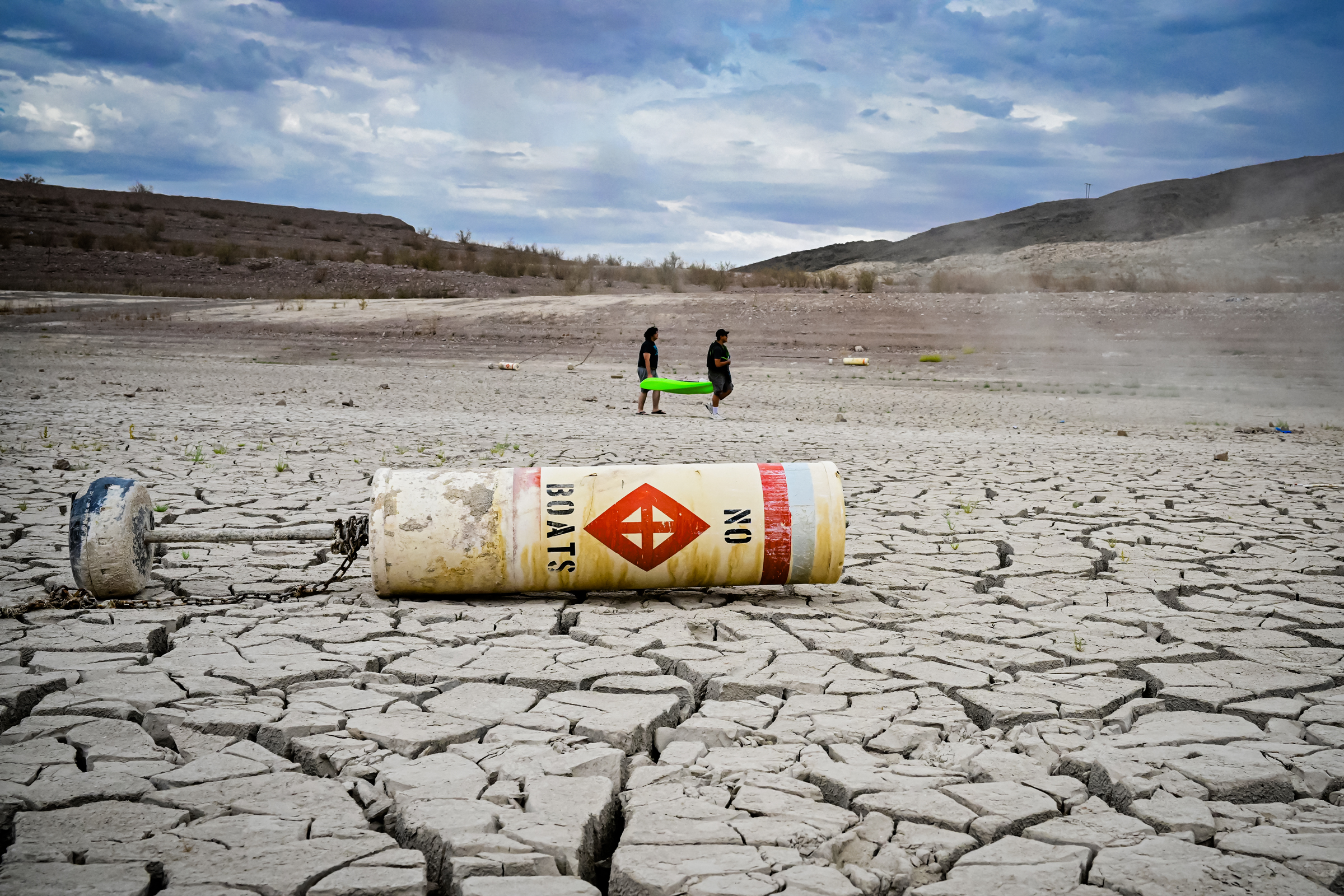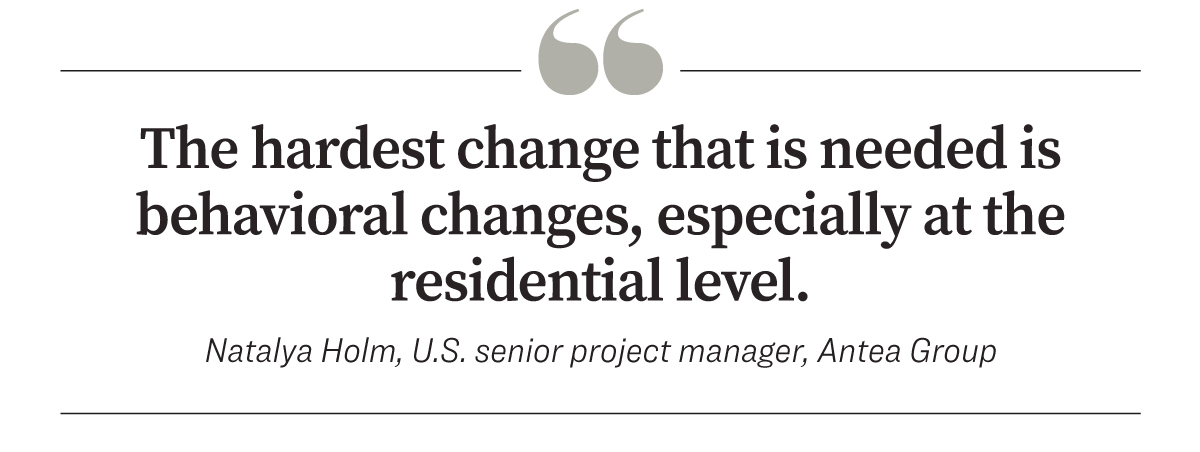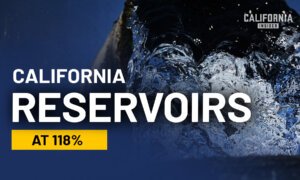The term “Day Zero Water” has become synonymous with a worst-case scenario for public water resources. It refers to a moment at which a city or region’s water supply is almost depleted and officials cut tap supply to communities.
This crisis was narrowly averted in 2018 in Cape Town, South Africa, which approached the threshold of a Day Zero event after rationing was almost not enough.
Subsequently, environmental researchers and resource insiders have voiced concern over the possibility that water will run out in U.S. cities after years of drought have reduced groundwater in places such as the Great Plains and the Southwest.
In a recent study published in Nature, researchers noted “rapid groundwater-level declines” globally in the 21st century of more than 0.5 meters (20 inches) per year across 170,000 monitoring wells and 1,693 aquifer systems.
This includes water resources in the United States.
The study authors further observed that groundwater declines have accelerated over the past four decades, highlighting an “urgent need for more effective measures to address groundwater depletion.”
The Environmental Protection Agency (EPA) has also expressed concerns over national water assets.
The agency highlights on its website a Government Accountability Office report from 2014 that states that 40 out of 50 state water managers “expected shortages in some portion of their states under average conditions in the next 10 years.”
Groups such as the U.N. Environment Programme (UNEP) attribute much of the groundwater loss to climate change.
“The conditions in the American West, which we’re seeing around the Colorado River basin, have been so dry for more than 20 years that we’re no longer speaking of a drought,” Lis Mullin Bernhardt said in a May statement.
Bernhardt, an ecosystems expert at the UNEP, called it “aridification” and a “new very dry normal.”
However, some experts say poor water management and aging pipe infrastructure also play a significant role in depleting groundwater reserves.
“Given current consumption patterns and the increasing strain on water resources due to factors like climate change and population growth, a Day Zero water crisis is certainly a possibility for some U.S. cities,” Natalya Holm told The Epoch Times in an email.
Holm is a U.S. senior project manager for the Climate Risk & Water Stewardship Services Lead at Antea Group, an international environmental consulting firm.
She said the cities most at risk have a combination of high population density, limited water sources, and inadequate infrastructure to manage supply challenges.
“For instance, cities like Los Angeles, Las Vegas, and Miami face significant water stress due to their geographical location, reliance on limited local water sources, and high water demand caused by urbanization,” Holm said.

Park visitors look at the bleached “bathtub ring” visible on the banks of Lake Mead near the Hoover Dam in Lake Mead National Recreation Area, Ariz., on Aug. 19, 2022. (Justin Sullivan/Getty Images)
The Israel-based company Watergen, which makes water from the air, also identified Los Angeles and Miami—along with Atlanta, Phoenix, and El Paso—as urban centers at risk of a Day Zero event due to drought and saltwater contamination.
“Water supply sustainability and security can present a risk to communities if they are not proactively addressing these risks,” Barbara Martin, director of engineering and technical services at the American Water Works Association, told The Epoch Times via email.
Martin said communities face risks over water sustainability and security if officials aren’t proactive with infrastructure planning, asset management, and emergency preparedness.
She said that although nothing can eliminate the risk of a day zero water crisis, public educational resources will help, as will improved resilience planning by water asset managers.
Down the Drain
Water pipe infrastructure in the United States is in desperate need of repair.

The EPA estimates that the aging U.S. network of pipes and water mains loses 2.1 trillion gallons of treated drinking water every year.
The agency expects necessary replacements to cost $500 billion.
In May, the Biden administration announced a $3 billion initiative to replace toxic lead pipes in U.S. waterworks.
The funding is part of a more than $50 billion spending package already approved to upgrade U.S. water infrastructure.
The White House called the initiative “the largest investment in clean and safe water in American history.”
However, the number falls drastically short of the EPA’s estimated need for shoring up water loss due to leakage.
“Among the 2.2 million miles of pipe that comprise our drinking water infrastructure ... the EPA estimates that 240,000 water main breaks occur in the U.S. each year,” Martin pointed out.
She said that it’s critical to ensure that utilities have strong programs for asset management, capital improvement planning, condition assessment, and water loss control in addition to “supporting effective and timely infrastructure renewal and replacement.”
Martin emphasized that continued investment in U.S. water infrastructure is needed to address this challenge.
Holm called the U.S. water pipe network “unique” in its high number of water systems per capita.
“What that means is, especially in rural areas, there are a lot of very small water systems serving a very small population ... it leads to fragmentation and inefficiencies in water management, preventing coordinated efforts for sustainable water use and infrastructure upkeep,” she said.
This fragmentation complicates regulatory oversight and equitable access to safe and reliable water, according to Holm.
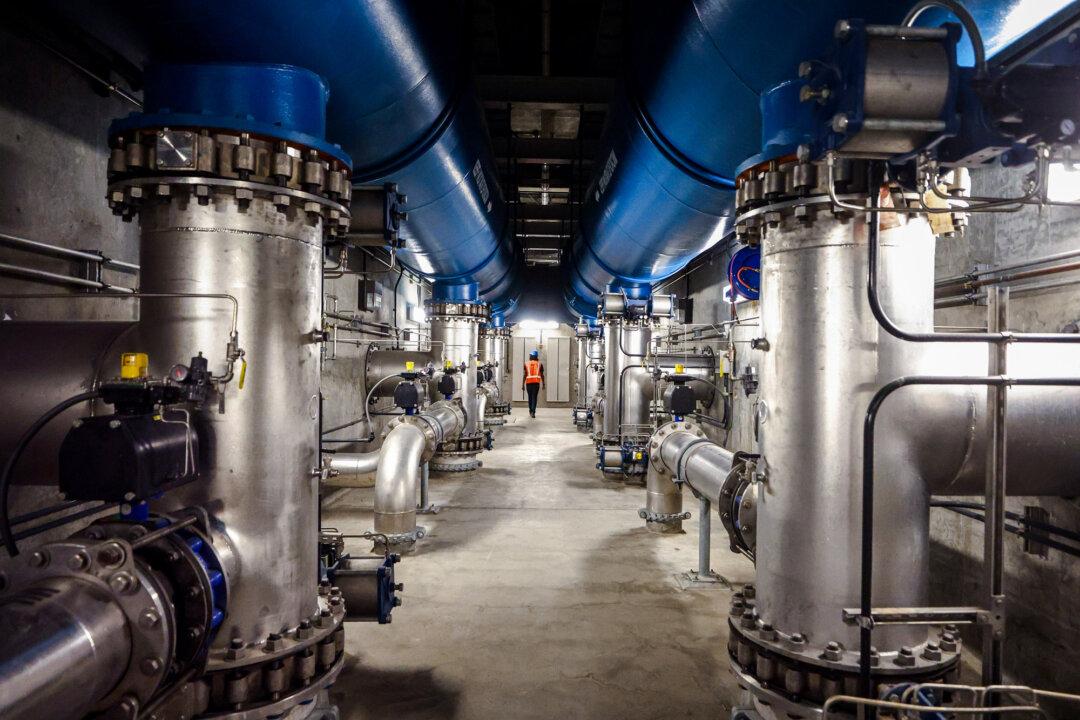
Wastewater undergoes the microfiltration treatment process at the Groundwater Replenishment System, the world's largest wastewater recycling plant, in the Orange County Water District in Fountain Valley, Calif., on July 20, 2022. (Mario Tama/Getty Images)
Ongoing water loss through pipe leakage is also a money hemorrhage for those working in resource management, she said. Some systems have reported water losses exceeding 60 percent. That kind of loss to pipe leakage is referred to as “non-revenue water.”
“The utility [company] brought it up from the ground or pulled it from a river, treated it, pumped it out into the system, used the energy to bring it out to the system, and got no revenue back from it,” Holm said.
“Nobody used it, and the water supplier lost out on 60 percent of the revenue, which means less money going into their infrastructure repair, improvement, and expansion funds.”
In its latest infrastructure report card, the American Society of Civil Engineers observed a water main break in the United States every two minutes, resulting in an estimated loss of 6 billion gallons of treated water every day.
“Addressing this issue requires substantial investment in infrastructure renewal and maintenance,” Holm said.
“This includes adopting modern technologies for leak detection and repair, prioritizing infrastructure upgrades in vulnerable areas, and enhancing coordination between federal, state, and local agencies to ensure effective management of water distribution networks.”

(Illustration by The Epoch Times, U.S. Drought Monitor)
However, failing pipe infrastructure amounts to more than just wasted water. Contamination from lead pipes has created ongoing health concerns in cities such as Jackson, Mississippi, and Flint, Michigan.
The Natural Resources Defense Council (NRDC) observed that Jackson has suffered from water issues such as discoloration, low pressure, oily appearance, and floating particles.
A decade after Flint’s infamous water contamination crisis began, the NRDC observed that the town still hasn’t finished its lead pipe replacement program.
Currently, the replacement project has damaged nearly 2,000 residential homes in Flint while dozens of others are still waiting for the city to test for lead in their water conduits.
Saltwater contamination in the country’s water is also on the rise, which contributes to water pipe degradation and reduced freshwater availability in groundwater supplies.
In 2019, the Maryland Department of Planning compiled a report estimating a 15 percent increase in state water salinity by 2025.
Inland penetration of saltwater is a problem that’s also been reported in Maine, Georgia, and South Carolina.
The famous resort area of Hilton Head in South Carolina has already witnessed the closure of 10 drinking water wells because of ocean water contamination, according to the island’s Public Service District.
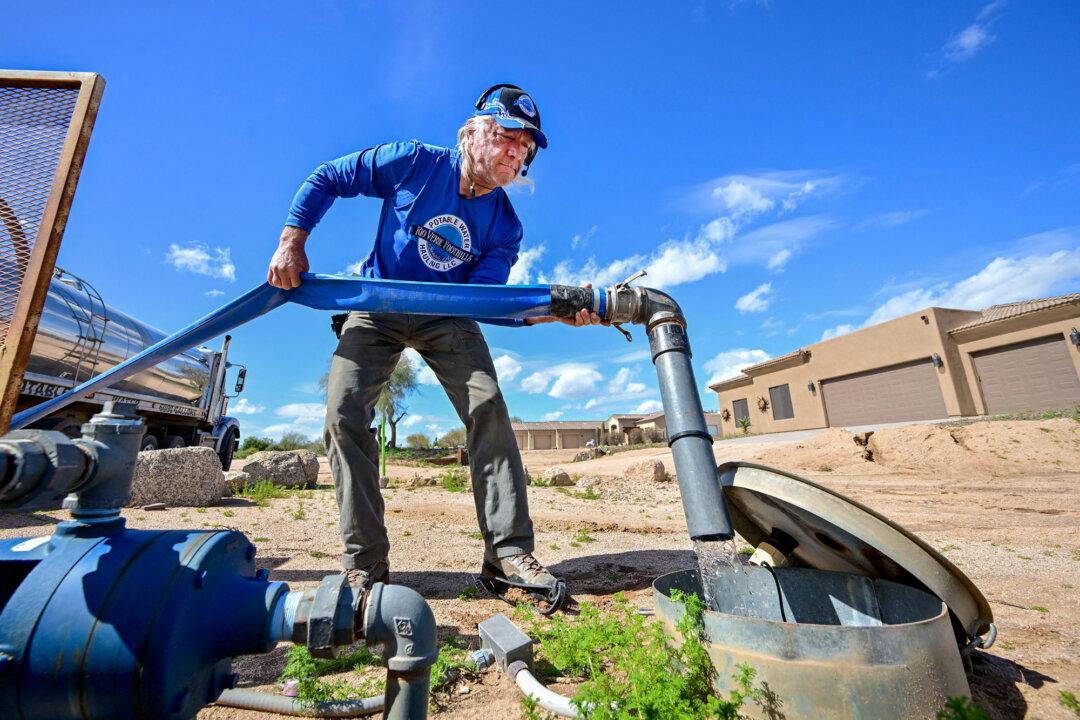
A man delivers water from his truck to a residential water tank in Rio Verde Foothills, Ariz., on Feb. 23, 2023. (Frederic J. Brown/AFP via Getty Images)
Usage Concerns
Water management experts say usage is another key factor affecting dwindling U.S. reserves.
Research suggests that the United States is among the world’s top water consumers.
An estimated 42 percent of the nation’s total freshwater usage goes to agricultural irrigation, according to the Department of Agriculture’s Economic Research Service.
Within cities, American families use more than 300 gallons of water per day, according to EPA findings.
Holm said she believes that water conservation in cities is where a crucial hurdle exists.
“The hardest change that is needed is behavioral changes, especially at the residential level,” she said.
“Encouraging water-saving practices such as using efficient fixtures, implementing smart irrigation systems and practices or opting for waterless landscaping, changing domestic habits, and promoting water conservation awareness campaigns can significantly reduce water consumption.”
Holm said saving water can be as simple as turning off the tap while soaping up in the shower.
A breakdown of total household water usage from the EPA shows that 20 percent is spent in the shower while another 24 percent goes to flushing toilets. Holm said large commercial water users are trying to reduce consumption.
One Colorado real estate broker says the combination of urban expansion and increased residential usage is fast-tracking his city for a Day Zero event.
“I expect to see a Day Zero in Colorado Springs in the next 30 years at the rate we are currently building,” Andrew Fortune, real estate broker and owner of Great Colorado Homes, told The Epoch Times via email.
Fortune said the home-building boom in Colorado Springs is putting a heavy strain on the city’s water supply.
“Water conservation is the No. 1 topic all developers talk about in Colorado Springs,” he said. “There are a few giant neighborhoods that are building faster than we can find water to service these areas. This is also a problem in Denver.”

A groundwater pump supplies water to Quechan tribal land at the Fort Yuma Indian Reservation, along the long-depleted Colorado River, near Winterhaven, Calif., on May 26, 2023. (Mario Tama/Getty Images)
Fortune said he believes that part of the problem is that the general public doesn’t know about the limitations on local groundwater.
He says tax incentives should be offered to people who have an almost plant-free yard, known as “zero-scaping.”
“There is a major difference between the water usage on a yard that is mostly rock and turf and those that require water weekly to keep from drying up in a week,” Fortune said.
He noted that golf courses and marijuana farms are some of the other “biggest culprits” of excess water usage in his area.
“Yes, we get tax incentives off of these businesses, but the environmental cost is not worth it,” Fortune said.
Colorado heavily regulates the collection of rainwater by residential property owners. Each household may collect and store a maximum of 110 gallons in rain barrels from house downspouts.
“As a water stewardship professional, I do think we have a long way to go on educating the public on water issues, as many struggle to grasp water scarcity when water continues coming out of their tap,” Holm said.
She said averting a Day Zero event will require a combination of public awareness campaigns, infrastructure upgrades, urban planning, and resource management—such as stormwater runoff and rainwater harvesting in select areas—that will help preserve water resources.
Fortune said his lingering question is whether it can all come together fast enough to avoid a catastrophic water crisis.
“First, cities have to admit that they are not sustainable,” he said.
“Perform a full-scale audit of the water usage for every neighborhood and business. Organize the list from the most consumption on down and then develop a strategy to tackle the issues now, before it’s too late.”
